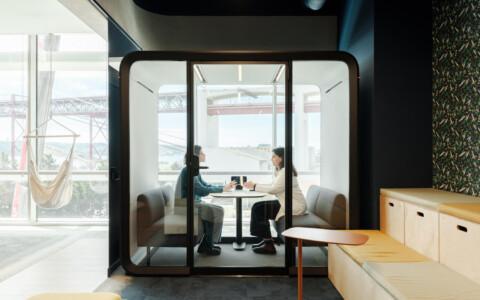Video calls have been around for ages since the needed technology and video conferencing software became widely accessible. The watershed moment for video conferencing, however, was the early 2020s which momentarily forced people into their homes and put business travel on hold. Work meetings and travel for business have not been the same ever since.
Key highlights
- Video conferencing allows meeting participants to attend meetings face-to-face regardless of their physical location.
- The additional visual component of video calls allows meeting participants to pick up non-verbal cues and, as a result, establish a more personal connection with each other.
- To make video conferencing work, offices need to be equipped with the right kind of technology and meeting rooms with video conferencing capabilities.
Is your office equipped for video conferencing?
Video conferencing enables virtual collaboration and brings people together over physical distances. With the right kind of technology and video conferencing software, video calls are now a viable alternative to in-person meetings. However, some workplaces make the mistake of replacing real face-to-face interaction with video calls but neglect to provide their employees with meeting rooms equipped for the purpose.
As employees no longer travel as frequently for in-person business meetings, there is a continued need for virtual collaboration. Video conferencing, for example, enables companies to offer flexibility in working locations, while still allowing teams to communicate with one another.
At Framery, we have been exploring all of the ways that our pods can support these new norms.
”Framery pods are acoustically ideal for video conferencing, offering a private and echo-free space which is crucial for an effortless video conference. And when placed correctly in the office, that is they are easy and quick to access, our pods provide on-demand privacy which will be needed even more in the future”, tells Mikko Tamminen, Framery Market Intelligence Manager.
Explore all Framery pods

Benefits of video conferencing
Everyone at the workplace, including the employer, can benefit from video conferencing technology. However, the office itself should have readiness for virtual collaboration. Some benefits of video conferencing include:
- Flexibility. Thanks to video conferencing, employees have the freedom to work flexibly from remote locations. As a result, teams become more diverse when people from different locations and backgrounds come together. When adopting a hybrid working model, companies should establish clear policies for remote work.
- Improved communication. Unlike mere phone calls, the visual component of video conferencing allows employees to observe each other’s facial expressions and body language. Therefore, video calls can create a more intimate connection between clients and colleagues.
- Employee satisfaction and productivity. Workers experience better work-life balance and satisfaction when they can attend video meetings from home and, as a result, have more freedom in arranging their workdays.
- Cost savings. Business travel is still commonplace, but video conferencing capabilities have made companies reassess whether travelling to every meeting is necessary. When meetings can be conducted remotely over video conferencing software, companies do not have to spend their resources on travel expenses.
- Time efficiency. With less time spent commuting and travelling, video conferences leave more time for other, more productive work and free time outside of work.
- Environmental Impact. Apart from the direct benefits for companies and their employees, video conferencing is also more environmentally friendly when it replaces long overseas flights and commuting. Responsible companies have set their aims for more sustainable operations, and how they arrange meetings should be a part of this effort.
Avoid the pitfalls of video calls
Despite all its benefits for employers and employees alike, video conferencing has potential limitations when implemented carelessly. These disadvantages of video conferencing include distractions from colleagues, reduced personal connection in comparison to in-person communication, and meeting fatigue from too many video meetings during the workday.
Technical issues are another potential pitfall that can undo the time savings and productivity wins of video conferencing. Among these are choppy internet connections, incompatible meeting software, as well as hardware and meeting spaces that are ill-equipped for the purpose.

Equip your office for video calls with Framery
Framery is dedicated to ensuring that offices across the globe are equipped with the necessary solutions for employee success and happiness. In answering to companies’ needs for video conferencing-ready spaces, Framery office booths and pods remain a key solution.
Framery has teamed up with Logitech to create the optimal solution for the video conferencing needs of offices. Equipped with Logitech’s video conferencing setup, Framery pods and booths are tailor-made for teams and meetings of all sizes. With the right video conferencing setup, office workers can accommodate remote participants in their meetings as well. Do not let technical limitations come in the way of your video meetings!
Explore Framery + Logitech

FAQ about video conferencing
What is video conferencing?
Video conferencing refers to meetings where participants communicate via video over the internet without being physically in the same space. Unlike phone calls, video conferencing allows participants to pick up non-verbal cues and better connect with each other. Participants in a video meeting can all attend the call remotely via the internet or have some participants join together from the same location.
What are examples of video conferencing software?
Organizations have their own preferences for which video conferencing software they use in day-to-day operations. Most commonly, companies are committed to either the Microsoft or Google stack of software and, therefore, use either Microsoft Teams or Google Meet for video conferencing. Other popular video conferencing platforms include Zoom, Webex, Slack, and Skype.
What are the benefits of video conferencing?
One notable advantage of video conferencing is that, in many instances, it removes the need for commuting and business travel. The freed time spent on travel can be used for more productive work and activities outside of office. Additionally, companies can save on travel expenses and the cost of operating their office. Video conferencing is also an environmentally friendly alternative to business travel.
Get started today
Design your own
Customize your pod and make it your own with our pod configurator.

Get a quote
Find your nearest representative to hear about pricing and get a quote for your project.

Try a pod
Visit one of our global showrooms to try any of our Framery pods for yourself.





